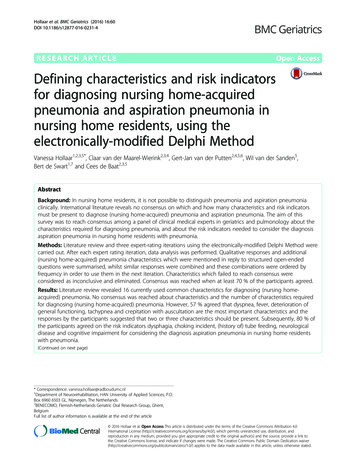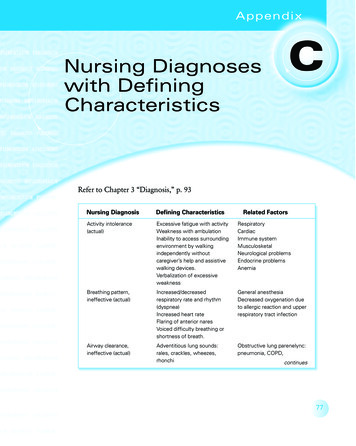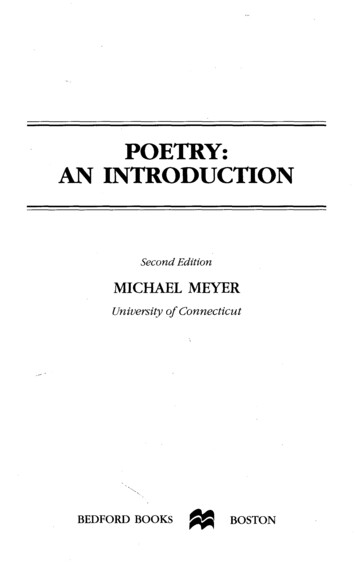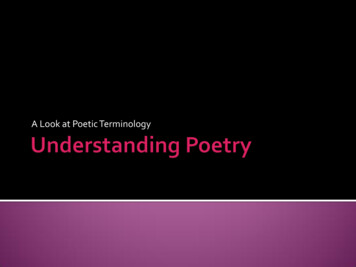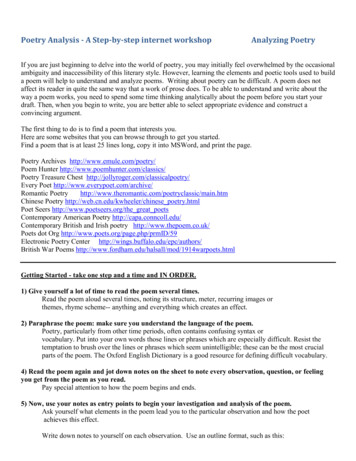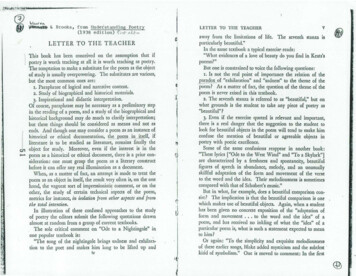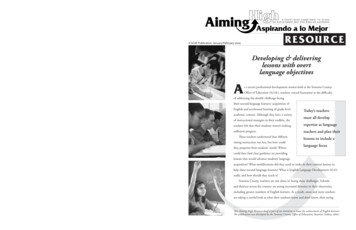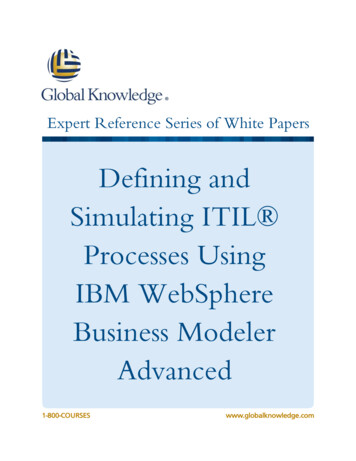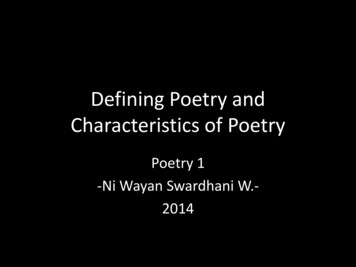
Transcription
Defining Poetry andCharacteristics of PoetryPoetry 1-Ni Wayan Swardhani W.2014
POETRY a universal phenomenon --- exists alonghuman’s civilization from primitive to developed nation from spell to drive away evil soul toconventional one (from oral to written) enjoyed by everyone entertainment andunderstanding never dies
“To fully understand Poetry, we first must befluent with its meter, rhyme, and figures ofspeech. Then ask two questions; one, how arefully the objective of the poem have beenrendered, and two, how important is theobjective. Question one rates the poem’sperfection, question two rates its importance.And once these questions have beenanswered, turning the poem’s greatness intorelatively simple matter. “Cont .
“If the poem scores for perfection is 5 on thehorizontal of the graph and its importance isplatted on its vertical, then calculating the totalarea of the poem yields the measure of itsgreatness. A sonnet by Byron might score highon the vertical, but only average on thehorizontal. A Shakespearean sonnet on theother hand would score high both horizontallyand vertically. Yielding the massive total areathereby revealing the poem to be truly great.”(Dr. J. Evans Prichard, PhD.) (20:20 – 20: 35)
To define what poetry one can give his or herown understanding of it because one’sperception about poetry is established byhis/her experience.
The Definition of Poetry The kind of thing poets write (Robert Frost) The spontaneous overflow of powerfulfeelings (William Wordsworth) The recollection of an emotion, which causesa new emotion (William Wordsworth)
Poetry is feeling confessing itself to itself, inmoments of solitude (John Stuart Mill) When we read a poem something happenswithin us. They bring to life a group of images,feelings, and thoughts (Stageberg & Anderson) Poetry is simply the most beautiful,impressive, and widely effective mode ofsaying things (Mathew Arnold)
Poetry teaches the enormous forces of a fewwords (R.W. Emerson) Poetry is the art of uniting pleasure with truthby calling imagination to help reason (SamuelJohnson) Poetry is the record of the best and happiestmoments of the happiest and best mind(Percey Bysche Shelley)
HOW TO READ POETRY? Read it more than once don’t scan or skim you won’t get it Use standardized dictionary Don’t stop at every line line sentence be careful at stopping run on-line orend stopped line? Read the poetry aloud to determine its rhythm related to tone and theme use English accent instead of Indonesian
Now,let’s go check your book onpage 2
Types of Poetry lyric Narrative dramatic.Classifications of this kind are not exclusive.Poems in each of these categories may haveelements characteristics of the other.
Lyric Poetry the most popular form of poetry today characterized by the expression of thespeaker’s innermost feelings, thoughts, andimagination. lyric a stringed musical instrument, lyre was used in classical and medieval times toaccompany a singer.
lyric poems are melodic melody not derived from a lyre but fromthe words and their arrangement thewords that accompany the melody in a songare called lyrics (Pickering and Hoeper, 1980).
Types of Lyric poetry:– pastoral poema poem telling the life in the countryside such asshepherds, cattle, hills, and mountains.– poem of praise– odea lyric poem that expresses a noble feeling withdignity.– elegya poem of lamentation.
Narrative Poetry tells a story the poet takes on a role similar to of anarrator in a work of fiction Ballad is narrative poem which is quitepopular and there is Epic as well.
Ballad is strongly marked by rhythm suitablefor singing Traditional British ballads:– in quatrains, or four-line stanzas lines 1 and 3 have four beats lines 2 and 4 have three beats and rhyme– usually an anonymous and it deals with thecomedies and tragedies of everyday life. Modern ballads:– composed by a certain poet no longeranonymous– the structure is generally the same
Epic– the longest narrative– it does not simply tell a single action but record away of life– the traditional / old epic is anonymous– Some examples: Beowulf consists of around 3000 line Dante’s Divine Comedy John Milton’s Paradise Lost
Dramatic Poetry Produced when a poet tries to break out of hisor her own consciousness and reach into theworld of another It provides the reader an opportunity to hearthe imagined thoughts of characters who lackthe poet’s opportunity of expression
Soliloquy the simplest form– the speaker is merely overheard, talking to no onein particular– is also called dramatic monologue (Bergman andEpstein, 1987,p.477-478). Some examples: William Carlos William’s The Widow’s lament inSpringtime William Blake’s The Little Vagabond
Basic Approaches to Poetry Objective approach– the oldest and traditional one– begins with a complete description of the poem’sphysical properties such as its length, rhymescheme and figures of speech– the analysis proceeds to give more complexinformation about why the poet chooses toinclude them and also how is the meaning of thepoem conveyed through the use of the technicaldevices
Subjective Approach– begins with personal interest in the poem respond to a poem based on our experience.– No deep analysis over the poem’s structure butmore into what the poem means to us mayproduce a variety of interpretation.– weakness in term of its relativity too subjective We should consider the variouspossible responses (Reaske, 1966) this approach can lead to the ignorance of literary cluesthat one should take into account
Thematic Approach– sometimes also deals with the theme of the poem that is what to search for when reading a poem– theme is the main idea of a work– It is the poet’s view about phenomena presentedin the poem.– It usually provides an insight about human life.– thematic approach attempts to find what a poemis saying.
Versification in Poetry
Prosody the pronunciation of a song or poem the general word describing the study ofpoetic sounds and rhythm Prosody versification (the study of the structure of a verse),mechanics of verse, and music of poetry.
poetry often requires a regular beat, anappropriate speed and expressiveness ofdelivery just like music they help the poets convey the meanings oftheir words or facilitate the readers tounderstand the ideas, the emotions the poetscommunicate through their words. the analysis of a poem’s prosodic techniquecannot be separated from that of its content.
Rhythm created by the pattern of repeated sounds—interms of both duration and quality—and ideas a combination of vocal speeds, rises and falls,starts and stops, vigor and slackness, andrelaxation and tension
Rhythm is significant because poets “invite”the readers to change speeds while reading—to slow down and linger or pass rapidly oversome words and sounds or to give more orless vocal stress or emphasis on certainsyllables. All these are related to emotions that arecharged in the poem.
Scansion the act of scanning a poem to discover howthe poem establishes a metrical pattern—which syllables are accented (receive stress)and which are not (receive no stress). the accented syllables are usually indicated bya prime mark or acute accent ( / ) the unaccented ones are marked with a bowllike half circle called a breve ( ̮ )
Metrical Feet Poetic foot a line of a poem seems to bedivided into a number of repeated unitscombining the same number of accented andunaccented syllables. A pattern of one foot is repeated or varied inthe entire poem, the pattern for the poem isestablished To separate one foot from another, a slash (/)is used.
The IambAdjective: iambic; consisting of 1 unaccentedsyllable followed by 1 accented syllable(Wordsworth, The World Is Too Much with Us)
The TrocheeAdjective: trochaic; consisting of 1 accentedsyllable followed by 1 unaccented syllable(Donne, Song)
The SpondeeAdjective: spondaic; consisting of 2 accentedsyllables
The AnapestAdjective: anapestic; consisting of 2 unaccentedsyllables followed by 1 accented syllable(Key, Defence of Fort McHenry)
The DactylAdjective: dactylic; consisting of 1 accentedsyllable followed by 2 unaccented syllable(Swinburne, Songs before Sunrise)
The Pyrrhic2 unaccented syllables(Tennyson, In Memoriam)
The Metrical Linethe number of feet contained in a lineNumber offeet in a lineName of ter6Hexameter7Heptameter8Octameter
The Caesura The pause in a line, which is often bestdiscovered by reading the poem aloud. Thepause is not necessarily punctuated. Thecaesura can be marked with (//). Example: Milton! // Thou shouldst be living at this hour.(Wordsworth, London, 1802)
End-stopped line A line of poetry that naturally pauses at theend of the line (when it shows a completeclause or sentence) It is the opposite of run-on line, where readersshould not stop but read through to the nextline.
End-stopped line:My mistress' eyes are nothing like the sun.Coral is far more red than her lips red.(Shakespeare, Sonnet 130)Run-on lines:Let me not to the marriage of true mindsAdmit impediments. Love is not loveWhich alters when it alteration findsOr bends with the remover to remove. . . .(Shakespeare, Sonnet 116)
Rhythm exercise 1My mistress' eyes are nothing like the sun.Coral is far more red than her lips red.
Iambic Pentameterv/ v/v / v/ v /My mis/tress' eyes/ are no/thing like/ the sun.v / v /v/v /v /Coral/ is far/ more red/ than her/ lips red.
Rhythm exercise 2Let me not to the marriage of true mindsAdmit impediments. Love is not loveWhich alters when it alteration findsOr bends with the remover to remove
Iambic Pentameterv / v / v /v/ v/Let me/ not to/ the ma/rriage of /true mindsv / v / v /v / v /Admit/ impe/diments. /Love is /not lovev/ v/v / v / v /Which al/ters when/ it al/tera/tion findsv /v / v / v / v /Or bends/ with the/ remo/ver to/ remove
Rhythm exercise 3Double, / double / TOIL and / trouble;fire / BURN, and / caldron / bubble.(Macbeth by Shakespeare)
Trochaic Tetrameter/ v/ v/ v/ vDouble, / double / toil and / trouble;/v/v/ v/ vFire / burn, and / caldron / bubble.
Rhythm exercise 4Half a League, Half a League(The Charge of the Light Brigade by Tennyson)
Dactyl Dimeter/ vv/ v vHalf a League,/ Half a League
Rhyme the identical final syllables of words may appear in two successive lines, inalternating lines, or at intervals of four, five, ormore lines if rhyming sounds are too far away from eachother, they lose their immediacy andeffectiveness.
Functions:– delight– strengthens a poem’s psychological impact– support memorization on the poem How to describe rhyme scheme:– the first sound at the end of a line “a”,– the next is “b”, then “c”, “d”, and so on.– when a sound reappear use the same letter tolabel the sound
Rhyme is determined by sound, not spelling. Which of these two pair of words rhyme?puff / enoughthrough / though
The pronunciation of words has changedgreatly since the Renaissance. Give some thought to how a word might havesounded before you decide "That doesn'trhyme" and throw the book down in disgust! Word meanings have changed, too, and theOxford English Dictionary is the suggestedbest place to look up words and figure outwhat they meant at the time a particularauthor was writing.
Can you decide the rhyme scheme?I thought of Thee, my partner and my guide,As being past away. -Vain sympathies!For backward, Duddon! as I cast my eyes,I see what was, and is, and will abide;Still glides the Stream, and shall not cease to glide;The Form remains, the Function never dies;While we, the brave, the mighty, and the wise,We Men, who in our morn of youth defiedThe elements, must vanish; -be it so!Enough, if something from our hands have powerTo live, and act, and serve the future hour;And if, as toward the silent tomb we go,Through love, through hope, and faith's transcendent dower,We feel that we are greater than we know.(Alfred Lord Tennyson – After Thought)
Variations of Rhymes Perfect rhyme and half rhyme– Perfect rhymes the stressed vowel following sounds areidentical slow - grow, fleet - street, or buying –crying– Half rhymes the final consonant sounds of the words areidentical, but the vowels are different, creatingsimilar but not identical sounds quietness - express
Masculine and feminine rhyme– Masculine rhyme the final syllables of the rhyming words arestressed inquired – desired.– Feminine rhyme the rhyming of stressed syllables followed byidentical unstressed syllables flowers – bowers.
Internal rhyme– the rhyming words are found within the line,– often a word in the middle of a line rhyming withthe last word or sound of the line. Small feet were pattering, wooden shoes clattering,(Browning, The Pied Piper of Hamelin)
Alliteration– the identical consonant sounds that start severalwords that are close to each otherFor winter's rains and ruins are over,And all the season of snows and sins;The days dividing lover and lover,The light that loses, the night that wins;(Swinburne, Chorus from Atalanta)
Slant Rhyme– Assonance the repetition of identical vowel sounds indifferent words that are close to one another bird and thirst identical /er/ sound– Consonance words have the same consonants but not thesame vowel sounds pat and pit
Onomatopoeia– a blend of consonant and vowel sounds designedto imitate or suggest a situation or action– the use of word which sound suggests its meaning buzz, crackle, hum, etc. Blank verse– unrhymed iambic pentameter– Shakespeare’s plays and Milton’s Paradise Lost
Free verse– free of the traditional patterns of lines and meter– the rhythm is based on the stress resulting fromth
understanding never dies “To fully understand Poetry, we first must be fluent with its meter, rhyme, and figures of speech. Then ask two questions; one, how are fully the objective of the poem have been rendered, and two, how important is the objective. Question one rates the poem’s perfection, question two rates its importance. And once these questions have been answered, turning the .
